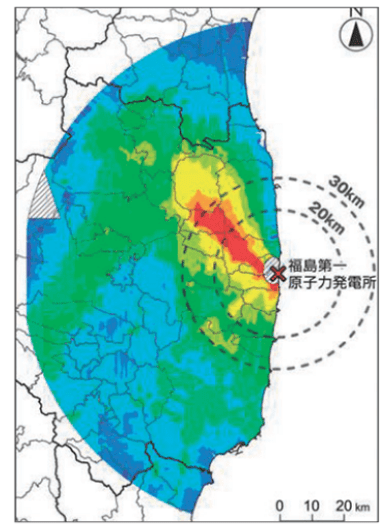Environmental Restoration Efforts and Reconstruction Progress in FukushimaThe 29th UN Climate Change Conference (COP29)
Decontamination

Decontamination
In order to reduce the impact of radiation on people and the environment, radioactive materials are removed or covered with shielding materials.
Long-term Goals
In addition to the natural attenuation of radioactive materials, decontamination and health management measures are aimed to keep the additional exposure dose below 1 mSv/year in the long term.

Decontamination Methods
Radioactive cesium is easily adsorbed by clay minerals, and once fixed, it is difficult to dissolve in water. Therefore, in order to reduce the radiation dose from radioactive materials in the environment, we first took measures to remove, shield, and keep the soil with away from radioactive cesium attached.

Current Situation
Air dose rate compared to the immediate aftermath of the accident is on a steady downtrend.

2011 (1 month after the accident)
Note: These maps include air dose rates from natural radionuclides.
[Source]
Nuclear Regulation Authority, Japan
“Results of Airborne Monitoring in Fukushima and Neighboring Prefectures and the 18th Airborne
Monitoring in the 80 km zone from the Fukushima Daiichi NPP” dated February 22, 2024

2023 (152 months after the accident)
The air dose rate in Fukushima is equivalent to Major Cities around the world.
Air dose rates in Fukushima Prefecture have dropped to levels similar to those in major cities around the world.

Also, A continuous decontamination effect has been observed.
Decontamination in residential areas reduced the radiation dose by 60%, and a subsequent investigation showed that it had fallen by 76%.This confirms that the effects of surface decontamination are being maintained.

[Timing]
Pre-decontamination measurement: Nov. 2011 – Nov.
2016
Post-decontamination measurement: Dec. 2011 – Nov. 2017
Subsequent monitoring: Oct. 2014 – Aug.
2018
* Average value of the air dose rate in residential areas, agricultural land, forests,
and roads (aggregation of measurement point data)
* Residential areas include schools, parks, graveyards,
and large-size facilities. Agricultural land includes fruit farms. Forests also include slopes, plains, and
grasslands.
Status of Evacuation Areas












